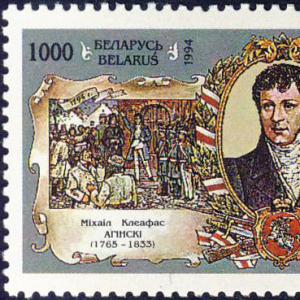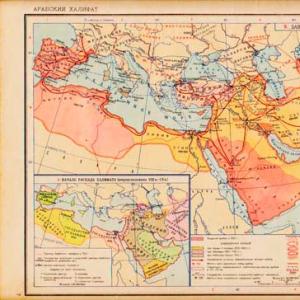Wars of the Byzantine Empire throughout history. Byzantine-Arab wars
With the performance of the Arabs, a new period begins in the history of all three parts of the Old World. Muhammad founded a religion that spread with alarming speed among the peoples of Asia and Africa, moreover, far beyond the borders in which the influence of Greek education, the power of the Roman state and the beliefs of the Christian church were in force. The Arabs united by Mohammed acted as conquerors who founded a huge power, and she took away from the former world monarchy almost all her Asian regions and decisively all African regions, and even transferred her conquests to Europe. From the very beginning of this new period flared up struggle between christianity and islam, constituting one of the most important phenomena in the history of the Middle Ages.
56. First Arab conquests
Already Muhammad, having united the Arab tribes under his rule, was thinking of undertaking a campaign against Syria. The first successor undertook to fulfill this covenant of the prophet, who took the title of his governor (Caliph) Abu Bakr. Circumstances favored this plan. The long-standing struggle between Byzantium and Persia had weakened both these states, and the result was the ease with which the Arabs, thirsty for prey and obsessed with religious fanaticism, conquered the various countries belonging to the Persians and Greeks. In a short time under the first two caliphs (the second was Lobster) they took possession of Syria, Mesopotamia, Persia and Egypt, which greatly reduced the Byzantine possessions outside Europe. It was Holy war, the purpose of which was the spread of Islam, and the speed with which the conquests were accomplished, giving the impression of a miracle, inflamed the Arabs still more to further enterprises of this kind. However, in some cases the conquerors were wary of forcibly imposing a new religion on the vanquished and were content with their mere obedience.
Borders of the Caliphate at the time of Omar's death (644)
57. Formation and expansion of the Caliphate
From Arabia with the countries conquered by Abu Bekr and Omar, a powerful state was formed, which in history received the name caliphate. After the death of the second caliph, who fell at the hands of the murderer, and the third caliph, Osman, the new state was shaken by unrest caused by the question of who should become the "viceroy of the prophet." The guardians and masters of Mecca, the Quraysh, were divided into two parties, and between their candidates, of whom one was Ali, nephew and son-in-law of Muhammad, and others Muawiya, commander of the troops in Syria, there was a struggle that ended in the defeat of Ali. This internecine strife also gave rise to a religious split in the Muslim world on Sunnis And Shiites, of which some, besides the Koran, began to recognize the sunnah as an authoritative interpretation of the holy book, while others - namely the supporters of Ali - rejected the sunnah, on the contrary.
Muawiya became the ancestor of a dynasty Umayyads(656–750), who transferred the capital of the Caliphate from Mecca to Damascus, from poor and ignorant Arabia to rich and cultured Syria. Here, under the influence of the old culture, the caliphate turned into a power reminiscent of by their structure and character, the former eastern monarchies. The Umayyads continued to expand the boundaries of the Caliphate. In Asia, they included in their monarchy Armenia And Turkestan, in Africa - province of Bizacenu, formerly the Vandal kingdom, and Mauritania. In 711, the Arabs crossed from Africa to Spain through the strait, which, after their leader Tarik, became known as Gibraltar (Tariq's crossing). The Visigothic kingdom was conquered by them, and a few years later the Arabs even invaded Gaul, where, however, they suffered a severe defeat at Poitiers from a Frankish commander Karla Martella (732).
Shortly thereafter, the disintegration of the caliphate began. In 750, the ruler of one of the provinces of Persia rebelled against the Umayyads, Abu l-Abbas. He took possession of Mecca and Medina and became the founder of a new dynasty Abbasids whose capital was moved to Baghdad on the Tigris. In Spain, this coup was not recognized, and the Umayyads formed a special caliphate here, the main city of which was Cordova.

58. Arabs and Byzantium
The Arabs did not limit themselves to the indicated conquests of the Byzantine provinces in Asia, but continued to attack other parts of the empire. They managed to take possession for a while of some cities in Asia Minor and the islands of the Archipelago, and they became even approach Constantinople itself. At the beginning of the 8th century the capital of the empire was directly in danger of being captured by the Arabs, who surrounded it both from the sea and from land and did not want to leave for a long time. At this time, he became emperor Leo III the Isaurian(717–741), a skillful and brave commander who forced the Arabs to lift the siege. By the way, the so-called "Greek fire" was successfully used against their ships, a kind of gunpowder, with which the Byzantines were able to set fire to enemy ships. The failure of the Arabs at Constantinople did not stop, however, the war with them. The whole 8th century passed in the struggle of Byzantium and the Caliphate for the possession of Asia Minor and the Archipelago, and in the end the Greeks held them back.
59. Limits of the Byzantine Empire in the VIII century
The limits of the Byzantine Empire were reduced not only in Asia, but also in Europe. In the 7th century Slavs began to gradually establish themselves in the north of the Balkan Peninsula. Illyria was captured Serbs and on the lower reaches of the Danube mixed with the Slavs Bulgarians(a people of Turkic origin, who soon became completely Slavic) founded a large state, which showed a desire for further expansion; from the 8th century the territory of the Byzantine Empire is limited only the middle and southern parts of the Balkan Peninsula, the islands of the Archipelago and Asia Minor with a purely Greek or strongly Hellenized population. Within these limits, it was no longer so difficult for the Byzantines to defend the existence of the empire in a war on two fronts - with the Slavs and with the Arabs.
Warriors of the Byzantine Empire and the Arab Caliphate for dominance in the Eastern Mediterranean. The unified Arab state, created on the Arabian Peninsula by the prophet Muhammad, easily crushed the Persian Empire, shocked by the defeats from the troops of the Byzantine emperor Heraclius. In 633, Arab troops invaded Persian possessions. Their conquest of Persia was completed by 651. At the same time, Byzantium was subjected to the Arab invasion. The army of the Caliphate, numbering up to 27 thousand people, invaded Syria and Palestine. In 634, two years after the death of Muhammad, under the first caliph (i.e., "viceroy of the prophet") Abu Bekre, the Arabs captured the first significant Byzantine fortress of Bosra across the Jordan River. The following year, Damascus passed into their hands. On August 20, 636, a Byzantine army of 40,000 was defeated at the Yarmuk River, and all of Syria came under the control of the Arabs.
The defeat of the Byzantines was facilitated by strife between their leaders Vahan and Theodore. Both of them fell at the Battle of Yarmouk. Jerusalem surrendered to the Arabs in 638 after a two-year siege. At the same time, Arab troops occupied Mesopotamia. In 639, Arab detachments appeared at the borders of Egypt, but their further advance was stopped by a plague that spread in Syria and Palestine, which claimed the lives of 25 thousand people. In 641, shortly after the death of Emperor Heraclius, the capital of the province of Alexandria passed into the hands of the Arabs.
By the end of the 640s, the Byzantine troops completely left Egypt. The Arabs captured other Byzantine territories in North Africa, as well as part of Asia Minor. In the 650s, the Arab governor of Syria and the future caliph Moavia created a fleet in which the Greeks and Syrians served mainly. This fleet was soon able to fight on equal terms with the strongest Byzantine fleet in the Mediterranean. Further conquests of the Arabs were temporarily stopped due to a clash between the caliph Ali and the Syrian governor. In 661, after the internecine war and the murder of Ali, Moavia became caliph and, having transferred the capital to Damascus, resumed hostilities against Byzantium. In the late 660s, the Arab fleet repeatedly approached Constantinople. However, the besieged, led by the energetic Emperor Constantine IV, fought off all the attacks, and the Arab fleet was destroyed with the help of "Greek fire" - an explosive thrown out by special vessels (siphons) and ignited when it hit the ships. A feature of Greek fire was that it could burn on the surface of the water. In 677, the Arab ships were forced to leave their base of Cyzicus near Constantinople and go to the Syrian ports, but almost all of them died during a storm off the southern coast of Asia Minor. The Arab land army was also defeated in Asia Minor, and Moavia was forced to conclude a peace with Constantine, according to which the Byzantines paid a small tribute to the Arabs every year.
In 687, the Byzantines managed to recapture Armenia, and the island of Cyprus was recognized as a joint possession of the empire and the caliphate. At the end of the 7th - beginning of the 8th centuries, the Arabs conquered the last Byzantine possessions in North Africa - Carthage and the fortress of Septem (now Ceuta).
In 717, the Arabs, led by the brother of the caliph, the Syrian governor Maslama, approached Constantinople and on August 15 began a siege. On September 1, the Arab fleet, numbering more than 1800 ships, occupied the entire space in front of Constantinople. The Byzantines blocked the Golden Horn with a chain on wooden floats, and the fleet led by Emperor Leo III inflicted a heavy defeat on the enemy. His victory was greatly facilitated by the "Greek fire". The siege dragged on. In winter, famine and disease began in the Arab camp. The Bulgarians, allied with Byzantium, destroyed the Arab detachments sent for food to Thrace. By spring, Maslama's army was in a desperate situation. According to the Byzantine historian Theophanes, the Arabs "devoured all kinds of carrion, horses, donkeys and camels. They even say that they ate human corpses and their own droppings in pots, mixing it with leaven." The Arab squadron, which arrived in the spring of 718, sent by the new caliph Omar II, was defeated by the Byzantine fleet. At the same time, part of the sailors from Egyptian Christians, along with their ships, went over to the side of the emperor. The overland reinforcements were stopped by the Byzantine cavalry at Nicaea and turned back. A plague broke out in the Arab army near Constantinople, and on August 15, 718, exactly one year later, the siege was lifted. The retreating fleet was partially burned by the Byzantines, and partially perished during a storm in the Aegean Sea. Of the 180 thousand Arab soldiers and sailors who participated in the campaign, no more than 40 thousand returned home, and only 5 out of more than 2.5 thousand ships. This failure undermined the forces of the caliphate and forced the Arabs to abandon full-scale military operations against the Byzantine Empire for two decades .
The last major Arab invasion of Byzantium took place in 739. But already in 740, in a battle near the town of Akroinon in Asia Minor, the army of Emperor Leo III and his son Constantine V almost completely destroyed the Arab army. After that, the Byzantines conquered part of Syria, and the expansion of the Arabs into Asia Minor and Eastern Europe ceased forever. In the second half of the 10th century, Byzantium resumed expansion in the Eastern Mediterranean. On March 7, 961, the invincible Byzantine commander Nicephorus Foka, having gathered the entire fleet of the empire and 24 thousand soldiers, defeated the Arab fleet near Crete and landed on the island. Following this, the Byzantines massacred the entire Arab population of Crete. Having become Emperor Nicephorus II in 963, Foka continued the war with the Arabs. In 965 he captured Cyprus and Cilicia, and in 969 Antioch. Later, in the 11th century, these territories were conquered by the Seljuk Turks.
Palestine, Syria, Egypt, Crete, Sicily, North Africa, Asia Minor, Armenia East Thrace
Arab-Byzantine wars - a number of military conflicts between the Arab Caliphate and the Byzantine Empire during the 7th-12th centuries. The beginning of the wars marked the invasion of the Arabs into Byzantium in the 630s and the beginning of the territorial seizures on their part. As a result of these wars, Byzantium lost a large number of its territories in the east and south: Palestine, Syria, Armenia, Egypt, North Africa, Cyprus, Crete, Sicily, and part of Asia Minor. The initial part of the conflict continued in 634-717 and ended with the second Arab siege of Constantinople, after which the Arabs were defeated and the threat of the capture of Asia Minor by them was averted. In the period from the 800s to 1169, the war, albeit sluggish, continued. First, the Arabs captured the southern Italian territories of Byzantium (the island of Sicily) in the 9th and 10th centuries. However, under the emperors of the Macedonian dynasty at the end of the 10th century, Byzantium went on the offensive and conquered part of the Levant from the Arabs, and in particular such an important outpost as Antioch. The Byzantine army at that time even put Jerusalem in immediate danger. The Arab Sultanate of Aleppo recognized itself as a Byzantine vassal. At that time, Crete and Cyprus were also reconquered. After the Seljuk conquests, the situation completely changed. Byzantium was driven out of Asia Minor, and the Abbasid Caliphate was significantly weakened. There were no more important conflicts between the Arabs and Byzantium.
The unified Arab state, created on the Arabian Peninsula by the prophet Muhammad, easily crushed the Persian Empire, shocked by the defeats from the troops of the Byzantine emperor Heraclius. In 633, Arab troops invaded Persian possessions. Their conquest of Persia was completed by 651.
At the same time, Byzantium was subjected to the Arab invasion. The army of the Caliphate, numbering up to 27 thousand people, invaded Syria and Palestine. In 634, two years after the death of Muhammad, under the first caliph (i.e., "vicar of the prophet") Abu Bekre, the Arabs captured the first significant Byzantine fortress of Bosra across the Jordan River. The following year, Damascus passed into their hands. On August 20, 636, a Byzantine army of 40,000 was defeated at the Yarmuk River, and all of Syria came under the control of the Arabs.
The defeat of the Byzantines was facilitated by strife between their leaders Vahan and Theodore. Both of them fell at the Battle of Yarmouk. Jerusalem surrendered to the Arabs in 638 after a two-year siege. At the same time, Arab troops occupied Mesopotamia. In 639, Arab detachments appeared at the borders of Egypt, but their further advance was stopped by a plague that spread in Syria and Palestine, which claimed the lives of 25 thousand people.
In 641, shortly after the death of Emperor Heraclius, the provincial capital passed into the hands of the Arabs. By the end of the 640s, the Byzantine troops completely left Egypt. The Arabs captured other Byzantine territories in North Africa, as well as part of Asia Minor.
In the 650s, the Arab governor of Syria and the future caliph Moavia created a fleet in which the Greeks and Syrians served mainly. This fleet was soon able to fight on equal terms with the strongest Byzantine fleet in the Mediterranean. Further conquests of the Arabs were temporarily stopped due to a clash between the caliph Ali and the Syrian governor. In 661, after the internecine war and the assassination of Ali, Moaviya became caliph and, having transferred the capital to Damascus, resumed hostilities against Byzantium. In the late 660s, the Arab fleet repeatedly approached Constantinople. However, the besieged, led by the energetic Emperor IV, fought off all the attacks, and the Arab fleet was destroyed with the help of "Greek fire" - an explosive thrown out by special vessels (siphons) and ignited when it hit the ships. A feature of Greek fire was that it could burn on the surface of the water. In 677, the Arab ships were forced to leave their base of Cyzicus near Constantinople and go to the Syrian ports, but almost all of them died during a storm off the southern coast of Asia Minor.
The Arab land army was also defeated in Asia Minor, and Moavia was forced to conclude a peace agreement, according to which the Byzantines paid a small tribute to the Arabs every year. In 687, the Byzantines managed to recapture Armenia, and the island of Cyprus was recognized as a joint possession of the empire and the caliphate.
At the end of the 7th - beginning of the 8th centuries, the Arabs conquered the last Byzantine possessions in North Africa - Carthage and the fortress of Septem (now Ceuta). In 717, the Arabs, led by the brother of the caliph, the Syrian governor Maslama, approached Constantinople and on August 15 began a siege. On September 1, the Arab fleet, numbering more than 1800 ships, occupied the entire space in front of Constantinople. The Byzantines blocked the Golden Horn with a chain on wooden floats, and the fleet led by Emperor Leo III inflicted a heavy defeat on the enemy.
His victory was largely facilitated by the "Greek fire". The siege dragged on. In winter, famine and disease began in the Arab camp. The Bulgarians, allied with Byzantium, destroyed the Arab detachments sent for food to Thrace. By spring, Maslama's army was in a desperate situation. According to the Byzantine historian Theophanes, the Arabs “devoured all kinds of carrion, horses, donkeys and camels. They even say that they ate human corpses and their own droppings in pots, mixing it with leaven. The Arab squadron, which arrived in the spring of 718, sent by the new caliph Omar II, was defeated by the Byzantine fleet. At the same time, part of the sailors from Egyptian Christians, along with their ships, went over to the side of the emperor. The overland reinforcements were stopped by the Byzantine cavalry at Nicaea and turned back. A plague broke out in the Arab army near Constantinople, and on August 15, 718, exactly one year later, the siege was lifted.
The retreating fleet was partially burned by the Byzantines, and partially perished during a storm in the Aegean Sea. Of the 180 thousand Arab soldiers and sailors who participated in the campaign, no more than 40 thousand returned home, and only 5 out of more than 2.5 thousand ships. This failure undermined the forces of the caliphate and forced the Arabs to abandon full-scale military operations against the Byzantine Empire for two decades .
The last major Arab invasion of Byzantium took place in 739. But already in 740, in a battle near the town of Akroinon in Asia Minor, the army of Emperor Leo III and his son V almost completely destroyed the Arab army. After that, the Byzantines conquered part of Syria, and the expansion of the Arabs into Asia Minor and Eastern Europe ceased forever.
In the second half of the 10th century, Byzantium resumed expansion in the Eastern Mediterranean. On March 7, 961, the Byzantine commander Nicephorus Foka, having gathered the entire fleet of the empire and 24 thousand soldiers, defeated the Arab fleet near Crete and landed on the island. Following this, the Byzantines massacred the entire Arab population of Crete. Having become Emperor Nicephorus II in 963, Foka continued the war with the Arabs. In 965 he captured Cyprus and Cilicia, and in 969 Antioch. Later, in the XI century, these territories were conquered by the Seljuk Turks.
Arab-Byzantine wars, a number of military conflicts between the Arab Caliphate and the Byzantine Empire during the 7th-12th centuries. The beginning of the wars marked the invasion of the Arabs into Byzantium in the 630s and the beginning of the territorial seizures on their part. As a result of these wars, Byzantium lost a large number of its territories in the east and south: Palestine, Syria, Egypt, North Africa, Cyprus, Crete, Sicily, and part of Asia Minor.
The initial part of the conflict continued in 634-717 and ended with the second Arab siege of Constantinople, after which the Arabs were defeated and the threat of the capture of Asia Minor by them was averted.
In the period from the 800s to 1169, the war, albeit sluggish, continued. In the beginning, the Arabs capture the southern Italian territories of Byzantium (the island of Sicily) in the 9th and 10th centuries. However, under the emperors of the Macedonian dynasty at the end of the 10th century, Byzantium went on a counterattack and conquered part of the Levant from the Arabs, and in particular such an important outpost as Antioch. The Byzantine army at that time even put Jerusalem in immediate danger. The Arab Sultanate of Aleppo recognized itself as a Byzantine vassal. At that time, Crete and Cyprus were also reconquered.
After the Seljuk conquests, the situation completely changed. Byzantium was driven out of Asia Minor, and the Abbasid Caliphate was significantly weakened. There were no more important conflicts between the Arabs and Byzantium.
100 Great Wars Sokolov Boris Vadimovich
BYZANTINE-ARAB WARS (VII-IX centuries)
BYZANTINE-ARAB WARS
(7th-9th centuries)
Wars of the Byzantine Empire and the Arab Caliphate for dominance in the Eastern Mediterranean.
The unified Arab state, created on the Arabian Peninsula by the prophet Muhammad, easily crushed the Persian Empire, shocked by the defeats from the troops of the Byzantine emperor Heraclius. In 633, Arab troops invaded Persian possessions. Their conquest of Persia was completed by 651.
At the same time, Byzantium was subjected to the Arab invasion. The army of the Caliphate, numbering up to 27 thousand people, invaded Syria and Palestine. In 634, two years after the death of Muhammad, under the first caliph (i.e., "vicar of the prophet") Abu Bekre, the Arabs captured the first significant Byzantine fortress of Bosra across the Jordan River. The following year, Damascus passed into their hands. On August 20, 636, a Byzantine army of 40,000 was defeated at the Yarmuk River, and all of Syria came under the control of the Arabs.
The defeat of the Byzantines was facilitated by strife between their leaders Vahan and Theodore. Both of them fell at the Battle of Yarmouk. Jerusalem surrendered to the Arabs in 638 after a two-year siege. At the same time, Arab troops occupied Mesopotamia. In 639, Arab detachments appeared at the borders of Egypt, but their further advance was stopped by a plague that spread in Syria and Palestine, which claimed the lives of 25 thousand people.
In 641, shortly after the death of Emperor Heraclius, the capital of the province of Alexandria passed into the hands of the Arabs. By the end of the 640s, the Byzantine troops completely left Egypt. The Arabs captured other Byzantine territories in North Africa, as well as part of Asia Minor.
In the 650s, the Arab governor of Syria and the future caliph Moavia created a fleet in which the Greeks and Syrians served mainly. This fleet was soon able to fight on equal terms with the strongest Byzantine fleet in the Mediterranean. Further conquests of the Arabs were temporarily stopped due to a clash between the caliph Ali and the Syrian governor. In 661, after the internecine war and the assassination of Ali, Moaviya became caliph and, having transferred the capital to Damascus, resumed hostilities against Byzantium. In the late 660s, the Arab fleet repeatedly approached Constantinople. However, the besieged, led by the energetic Emperor Constantine IV, fought off all the attacks, and the Arab fleet was destroyed with the help of "Greek fire" - an explosive thrown out by special vessels (siphons) and ignited when it hit the ships. A feature of Greek fire was that it could burn on the surface of the water. In 677, the Arab ships were forced to leave their base of Cyzicus near Constantinople and go to the Syrian ports, but almost all of them died during a storm off the southern coast of Asia Minor.
The Arab land army was also defeated in Asia Minor, and Moavia was forced to conclude a peace with Constantine, according to which the Byzantines paid a small tribute to the Arabs every year. In 687, the Byzantines managed to recapture Armenia, and the island of Cyprus was recognized as a joint possession of the empire and the caliphate.
At the end of the 7th - beginning of the 8th centuries, the Arabs conquered the last Byzantine possessions in North Africa - Carthage and the fortress of Septem (now Ceuta). In 717, the Arabs, led by the brother of the caliph, the Syrian governor Maslama, approached Constantinople and on August 15 began a siege. On September 1, the Arab fleet, numbering more than 1800 ships, occupied the entire space in front of Constantinople. The Byzantines blocked the Golden Horn with a chain on wooden floats, and the fleet led by Emperor Leo III inflicted a heavy defeat on the enemy.
His victory was largely facilitated by the "Greek fire". The siege dragged on. In winter, famine and disease began in the Arab camp. The Bulgarians, allied with Byzantium, destroyed the Arab detachments sent for food to Thrace. By spring, Maslama's army was in a desperate situation. According to the Byzantine historian Theophanes, the Arabs “devoured all kinds of carrion, horses, donkeys and camels. They even say that they ate human corpses and their own droppings in pots, mixing it with leaven. The Arab squadron, which arrived in the spring of 718, sent by the new caliph Omar II, was defeated by the Byzantine fleet. At the same time, part of the sailors from Egyptian Christians, along with their ships, went over to the side of the emperor. The overland reinforcements were stopped by the Byzantine cavalry at Nicaea and turned back. A plague broke out in the Arab army near Constantinople, and on August 15, 718, exactly one year later, the siege was lifted.
The retreating fleet was partially burned by the Byzantines, and partially perished during a storm in the Aegean Sea. Of the 180 thousand Arab soldiers and sailors who participated in the campaign, no more than 40 thousand returned home, and only 5 out of more than 2.5 thousand ships. This failure undermined the forces of the caliphate and forced the Arabs to abandon full-scale military operations against the Byzantine Empire for two decades .
The last major Arab invasion of Byzantium took place in 739. But already in 740, in a battle near the town of Akroinon in Asia Minor, the army of Emperor Leo III and his son Constantine V almost completely destroyed the Arab army. After that, the Byzantines conquered part of Syria, and the expansion of the Arabs into Asia Minor and Eastern Europe ceased forever.
In the second half of the 10th century, Byzantium resumed expansion in the Eastern Mediterranean. On March 7, 961, the Byzantine commander Nicephorus Foka, having gathered the entire fleet of the empire and 24 thousand soldiers, defeated the Arab fleet near Crete and landed on the island. Following this, the Byzantines massacred the entire Arab population of Crete. Having become Emperor Nicephorus II in 963, Foka continued the war with the Arabs. In 965 he captured Cyprus and Cilicia, and in 969 Antioch. Later, in the XI century, these territories were conquered by the Seljuk Turks.
This text is an introductory piece. From the book of the Special Services of the Russian Empire [Unique Encyclopedia] author Kolpakidi Alexander Ivanovich author Sokolov Boris VadimovichEGYPTIAN-HITTI WARS (late XIV - early XIII century BC) Wars between Egypt and the Hittite power (the state of Hatti), which occupied the territory of Asia Minor, for dominance in Palestine, Syria and Phoenicia. According to Egyptian sources, the first to the borders Egypt attacked
From the book 100 great wars author Sokolov Boris VadimovichWARS OF ROME WITH THE BARBARS IN THE EPOCH OF THE "GREAT MIGRATION OF PEOPLES" (late 4th century - 5th century)
From the book 100 great wars author Sokolov Boris VadimovichBYZANTINE-GOTHIC WARS (VI century) The wars of the Byzantine Empire with the kingdoms of the Ostrogoths in Italy and the Visigoths in Spain. The goal of the Byzantine emperor Justinian was to regain control over the territories of the former Western Roman Empire and establish the hegemony of Byzantium in
From the book 100 great wars author Sokolov Boris VadimovichBYZANTINE-PERSIAN WARS (VI-VII centuries) Wars between the Byzantine Empire and Persia for hegemony in the Near and Middle East. Taking advantage of the diversion of the main forces of Byzantium under Justinian the Great to Italy, the Persian king Khosrov invaded Syria, occupied and plunder
From the book 100 great wars author Sokolov Boris VadimovichARAB CONQUESTS (VII-VIII centuries) The Arab tribes, who had lived on the Arabian Peninsula since the third millennium BC, were united into a single state in the 7th century by the prophet Muhammad, who became the founder of a new religion - Islam. This association
From the book 100 great wars author Sokolov Boris VadimovichWARS OF CHARLES THE GREAT (second half of the 8th - early 9th century) The wars of the Frankish king Charles, during which he founded the Holy Roman Empire. The basis of the Frankish army was heavy cavalry, recruited from wealthy landowners - vassals of the king. The infantry was
From the book 100 great wars author Sokolov Boris VadimovichRUSSIAN-BYZANTINE WARS (IX-X centuries) The goal of the Russian princes was to capture and plunder Constantinople. Prince Svyatoslav, in addition, hoped to gain a foothold on the Danube. On the part of Byzantium, the wars with Russia were of a defensive nature. In 941, the Russian prince Igor (Ingvar)
From the book 100 great wars author Sokolov Boris VadimovichBYZANTINE-BULGARIAN WARS (X - beginning of XI century) Wars of the Byzantine Empire with the Bulgarian kingdom. The goal of the Byzantines was to capture Bulgaria. The Bulgarian kings, on the other hand, sought to seize Constantinople and seize the Byzantine heritage in the Balkans. In 912 after
From the book 100 great wars author Sokolov Boris VadimovichTHE GERMAN-ITALIAN WARS (mid-X - end of the XII century) Wars of the German emperors in order to establish control over Italy. The emperors were opposed by the troops of the pope and the Italian feudal lords who supported him. In 951, Emperor Otto I succeeded in capturing
From the book 100 great wars author Sokolov Boris Vadimovich From the book 100 great wars author Sokolov Boris VadimovichRUSSIAN-LITHUANIAN WARS (end of the 15th - beginning of the 16th century) The wars of the Moscow and Lithuanian Grand Duchies for the East Slavic lands that were part of Lithuania. Since the middle of the 15th century, the influence of the Catholic Church in Lithuania has increased, associated with the strengthening of the union of this country with
From the book 100 great wars author Sokolov Boris VadimovichWARS OF THE GREAT MOGUL STATE (XVI-XVII centuries) These wars are associated with the conquests and subsequent civil strife in the Mughal Empire - the state that at that moment had the most powerful army in Asia. At the beginning of the XVI century, the territory of the Delhi Sultanate was invaded
From the book 100 great wars author Sokolov Boris VadimovichPOLISH-UKRAINIAN WARS (first half of the 17th century) Wars of the Ukrainian people against the Commonwealth for their independence. After the Union of Lublin, the lands of the Grand Duchy of Lithuania, located south of Polesie, became part of the Polish kingdom, which included
From the book 100 great wars author Sokolov Boris VadimovichRUSSIAN-TURKISH WARS (XYIII-XIX centuries) The wars of the Russian and Ottoman Empires for hegemony in the Black Sea basin and the Balkans. The first large-scale clash between Russian and Turkish troops took place in 1677-1678 in Ukraine. In August 1677, the Turkish army under
From the book Great Soviet Encyclopedia (PO) of the author TSB






